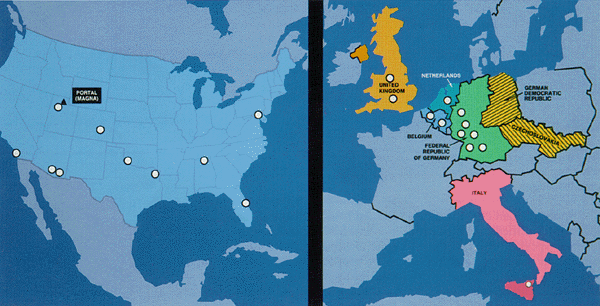| Setting Up An Agency | ||
| When
General Lajoie became OSIA's Director on February 1, he
inherited the work of the JCS task force. Lajoie came to
Washington from Paris, where he had been serving as the
U.S. Defense Attaché. Fluent in French and Russian, he
knew first-hand both Europe (the geographical arena for
the INF Treaty) and the Soviet Union, its military, and
its senior officer corps. His immediate tasks were to
organize the new DOD agency, participate in a series of
bilateral U.S.-Soviet negotiations on implementing the
treaty, and develop and train a cadre of inspectors and
escorts to conduct the on-site inspections.6 Acting quickly, General Lajoie made a key decision: he directed that the U.S. INF team chiefs, who would lead the 10-person teams into the USSR and escort Soviet teams in the United States and Western Europe, would be entrusted with extraordinary responsibility. During inspections, especially in the Soviet Union, the teams would be isolated, out of direct communications contact, and responsible for making on-the-spot judgments about treaty inspection issues. "I knew we would not have time," Lajoie recalled, "to come up with a comprehensive training program, well-developed procedures, and comprehensive guidance. If I picked good people, I could just rely on their judgment in the absence of all these other things." He interviewed and personally selected each team chief. "The thing that I keyed on [was that] I wanted someone who was familiar with the Soviet environment...but mostly, I wanted somebody whose judgment I could trust." 7 Each of the first 20 inspection team chiefs was an experienced field grade military officer. Most had at least 15 years of service, advanced degrees, Russian language proficiency, and experience in commanding small teams and military units. General Lajoie emphasized that they would be held accountable for establishing a professional, businesslike tone with the Soviets in conducting the U.S. inspection, escort, and portal monitoring missions. They were also responsible for team discipline, professionalism, and, to a degree, team training. They had to know the entire process of the on-site inspections under the treaty, including the treaty protocols and the Memorandum of Understanding. Decisions as to when to begin and terminate the on-site inspection would be, within certain timelines specified in the treaty, made by the team chief. Team chiefs would be responsible for preparing and signing, on site, the official INF Treaty Inspection Report for each inspection.8 Initially, team chiefs were instrumental in selecting team members. The treaty specified that on-site inspection teams be limited to 10 members for three types of INF inspections: baseline, closeout, and short-notice. For elimination inspections, the teams could be expanded to 20 members; for continuous portal monitoring inspections, the teams could have up to 30 inspectors. The first cadre of hand-picked team chiefs assisted in testing, interviewing, and selecting linguists, deputy team chiefs, and inspectors. |
 U.S. inspectors at Saryozek, USSR. "...mostly, I wanted somebody whose judgment I could trust." General Lajoie |
